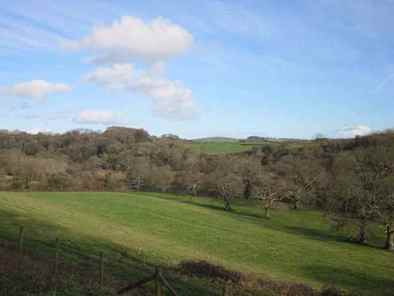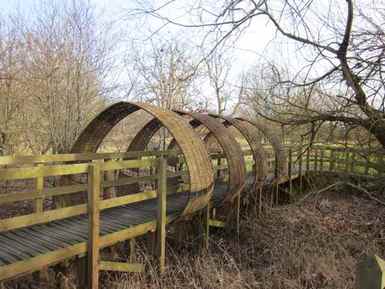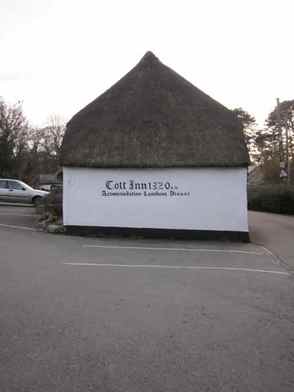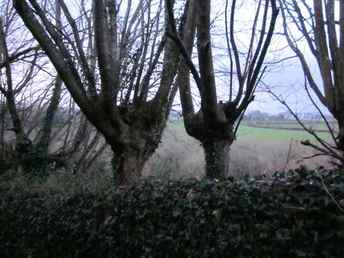|
This morning I left some time to sleep in (at least a bit) seeing as how I was still a bit 'knackered' from my red eye flight a few days before. The luxury of a comfortable bed is definitely not something to take lightly while on the road. I'd spoken with Martin Crawford at the Agroforestry Research Trust in Dartington, Devon the evening before and we'd pushed our meeting back till 2 in the afternoon which meant I had ample time to catch up and relax.
I was greeted by another beautiful west country day. Fast moving cumulus clouds interspersed with gorgeous baby blue backdrop made the dappled sunshine seem all that much more special. Relying on my mental compass which is usually quite reliable to bring me back to the railway station, I set off in a hurry to catch the 11:17 train to Totnes. Unfortunately, it (my compass) wasn't properly calibrated and I soon realized that I was not going to make it. Rather than worrying about rushing to a train I probably wouldn't have caught anyways, I elected to take a half hour in a small organic cafe I passed to settle into the late morning before truly setting off. I caught the next train bound for Totnes and had arrived within two hours time. The train ride through the west country was astonishingly beautiful. Rolling countryside, sinuous hedgerows and, occasional meanderings along the coast all made for a stunning journey. Upon arriving at the Totnes Station, I gave Martin a call and he told me I'd be there by foot within a half hour - that is, if I took the right way. Again relying on a mental compass that seemed to have been malfunctioning, I somehow just assumed I was headed off in the right direction - w arriving around midday left me a bit clueless to accurately determine my compass bering by the sun. For some reason I'd convinced myself I needed to pass through the town of Totnes to arrive at Dartington. This would have been true, if the train station was south of Totnes. So I set off for town , exploring the beauty of this compact, progressive, historic town, soon thereafter asking how to best arrive in Dartington. I then learned that instead of being 'roughly right' I had been 'precisely wrong' in my orientation (a saying Iearned from my natural building mentor Ianto Evans). I hurriedly set off in the other direction hoping to minimize the amount of time I'd l'd need to ask Martin to wait for me. Of course, retracing your steps makes a 30 minute journey far longer than if you'd set off in the right direction straightway. The bright side of it all was the fact that I'd had a chance to briefly explore Totnes - a town that has gained worldwide notoriety as of late as being the birthplace of the Transition Town movement. For folks unfamiliar - the Transition Town concept empowers community to develop an active, positivist vision of their community in a post petroleum future. It's based on community participation to develop a local and regionally focused roadmap towards a healthy, vibrant ecological future. Despite the short amount of time I spent on the high street in town, I could feel the vibrant energy of this eager and active community. As I made my way back to the train station, I asked for directions from several individuals who all gave different renditions of 'the right way' to get there. I set off on a footpath that followed the river which turned out to be a sweetly scenic passage and about 15 minutes later I'd arrived at the entrance to the Dartington Estate. Schumacher College and Martin Crawford's Agroforestry Research Trust and forest garden are but a few of the enterprises that call the estate home. It took another half hour or so to make my way to the forest garden, following the roadway through the heart of the estate, passing by the magnificent stone hall and other historic structures, massive oak, lined streets and patchy woodlands. All told it took an hour and a half of steady walking for me to arrive but I made it and spent the next hour with the brilliantly engaging Martin Crawford. I'd first learned about Martin's work while in college in 2000, having purchased several of his super-informative research documents detailing extensive lists of multi-purpose plants for various applications (Timber Trees for Temperate Climate, Plants for Hedging, Nitrogen-Fixing Plants, Ground Covers, etc.). The extent of his research and his contributions to temperate agroforestry are astounding. He'd first established a forest garden on the Dartington Estate with his partner in the mid-90s and has since developed the 2 acre site as a maturing, multi-species panoply of perennial plants that provides one of the best examples of intensive temperate forest gardening in the world. As a founder of the Agroforestry Research Trust, the publisher of the quarterly Agroforestry News, proprietor of an impressive multi-purpose plant nursery, educator, researcher, author of a new book on Forest Gardening and likely much much more, Martin in an indispensable wealth of information. My friend and colleague Justin West, a former Masters student and faculty member at Schumacher College and apprentice with Martin, put me in touch, suggesting that I visit to see some of Martin's applications of coppice and pollarding for nursery stock, leaf crops and other miscellaneous materials. I am grateful to have made his acquaintance. Martin first off mentioned that he maintains two sites for his work - the two acre forest garden at which I'd arrived and an 8 acre nursery and forest farm. There currently is no system for quantifying climate patterns in the UK or Europe as we do with the USDA hardiness zones in the States so they use our system there. Based on the lowest winter temperatures reached on a site during the year, hardiness zones have some flaws though. Technically, Devon would be a zone 8 - meaning that their lowest winter temperature is between 10 and 20 F. Pretty impressive for a site located at about 50 degrees N latitude. The detail that isn't compensated for here is the lack of summer heat at this northerly latitude. They while they can grow many things due to their mild winter, more tropical and sub-tropical plants can be difficult to get to fruit because they don't see they don't receive the summer heat required for fruiting. They receive fairly consistent rainfall there though climate change has been leading to a more irregular distribution. Generally speaking Martin said their annual average is about 1.1 meters (43" or so). With strong deer and squirrel pressure, he uses the 8 acre site as a production point for things like hazelnuts which would otherwise disappear before he had a chance to harvest any. That said, he's still growing hazel within the forest garden for rods he uses to stabilize nursery plantings during shipping. He has been actively coppicing (or actually pollarding about about 30" height) lime trees (Tilia spp. or in the States, linden) for the leaves for several years. Each year he cuts back the shoots from the boll formed at the top of the stems. This provides a vigorous crop of tender salad that he can harvest year-round. The trees produce new leaves throughout the season so he will steadily defoliate part of the stool at any given point but the tree continues to produce throughout the season. He told me it's difficult to quantify how much volume he ultimately harvests in a season due to a number of factors and we discussed the challenge of even accurately comparing this practice to that of planting and harvesting head lettuce or mesclun greens (how do you value the ease of perennial maintenance and harvest - no watering, seed starting, weeding, replanting, tilling, etc)? He said his system works for him and he's happy with it. Similarly he's pollarding some Italian alder at a low height (about 30" or so)within the forest garden to provide nitrogen rich mulch for trees within the forest garden as well as any subsequent root dieback and nitrogen release. This is a fairly common practice in forest garden management and makes a lot of sense as a low cost strategy for maintaining fertility within a garden regime. He's also taken to letting the alders grow out to full maturity as a canopy species on the north side of fruit trees without coppicing them. He shared plans to plant out a bald cypress (Taxodium distichum) plot that he intends to manage as coppice for a regular yield of fenceposts and rot resistant polewood. This species should do well on his site and has proved to grow well in this climate (as has the California redwood - Sequoia sempervirens - which had been planted nearby on the estate). Fencing is an important part of his agroforestry system to protect against browse from deer. After perusing the forest garden, Martin kindly offered to take me a few miles up the road to see the nursery site. Here, on a lovely south facing slope, we examined the black locust stand he'd planted 10 years ago and just felled this past winter. The trees had grown quite well, reaching about 7" in diameter. He'd primarily intended to grow the locust for fuelwood. Spacing them at about 3 meters,, he said in retrospect he'd likely have placed them closer to 6' on center. Many of the trees had forked at about 6' in height or so which was undesirable for his purposes. He's hoping that by coppicing them, he'll encourage suckering which will then fill in some of the gaps. To establish this mini-plantation, he'd procured root cuttings from a named Hungarian selection, chosen for it's shipmast like timber quality. Within the fenced in portion of the nursery, we could see rows of low pollards of species including walnut, chestnut............ which he was managing for cuttings and scionwood to feed his nursery operation. This seemed like an excellent system and a great application of plants' vigorous coppicing tendencies towards a productive use. We chatted a bit about ideas revolving around root die back as a result of coppicing and other species selections for coppice management before Martin dropped me off at the Dartington Estate. It was an action-packed 2 hour visit and I'm delighted to have had an opportunity to learn about his thoughts and application on his innovative R&D site. An inspiring and active man he is. From there, it was time for me to find my accommodation for the night. My good friends Adam Weisman and Katy Bryce had arranged a stay at a local B&B with a friend of their's Chris Bird. It took some asking around but I was eventually able to get fairly accurate directions to his house, meandering through the old shops of Dartington village (where I saw a massive old cider press and a re-activated overshoot water wheel that once powered a mill and now runs a 1 kW electric generator). Chris and his wife Karen proved to be gracious and engaging hosts. A comfortable and super affordable accommodation, I'd highly recommend them to anyone planning to pass through Totnes (visit www.birdsrest.com) Chris is active in the Transition Town Totnes group and recently wrote the new TT release 'Local Sustainable Homes' on building techniques and philosophy within the Transition framework. I took a nap before dinner and then shared cider and conversation until late in the night. The following morning, after pancakes with local black currant jam, Chris took me for a rainy walk through the woods of the Dartington Estate. On our return, we passed by a newly completed cob house (a traditional earthen building technique, basically wet built adobe or a mix of clay-sand and straw). This family built the structure largely on their own with help from a concrete contractor on the foundation and a thatcher and framer who created the roof structure. We had just enough time for a cup of tea and a bit of dry off time before Karen whisked me off to the railway station in Totnes to catch my train for the Cornish city of Truro. When I arrived at the station, I learned that the trains were indefinitely delayed because a car had somehow ended up on the tracks and needed to be removed by crane before they could allow train traffic to resume. After about a 45 minute delay and still no progress, the station master called the 6 of us heading to Cornwall outside and placed us in taxis which took us to Plymouth - the next major stop on the line. The ride took about 45 minutes and I was highly impressed that they provided us with this 'emergency' service. When we arrived at Plymouth, we were subject to the same delay and so they more or less immediately summoned another taxi that dropped us the remaining hour and a half to Truro. In all, these 2 taxi rides would have cost about 200 pound ($300!). Did I ever luck out. Especially considering that my friends Adam and Katy had been waiting for me in Truro which is about an hour's drive from their home. Fortunately in all I ended up being only about an hour behind schedule. It was great to see the two of them once I arrived. Fellow graduates of Oregon's Cob Cottage Company's natural building apprenticeship, the two of them took up residence in Cornwall (Adam is originally from Iowa, Katy from the UK) where they've proceeded to build a highly successful business restoring old cob buildings of which the countryside is littered. They have since gone on to take on a range of new design/build projects for clients throughout the country, including esteemed clients such as His Royal Highness Prince Charles - that's right, the Prince Charles! They've published 2 books on natural building - Building With Cob and Natural Paints and Finishes - and are now launching a new company - Clayworks - specializing in natural building products - namely an exquisite pre-mixed clay plaster. (www.clay-works.com) We returned to their lovely home in the village of Manaccan - a compact, old cob outbuilding that they've recently purchased and converted into a residence. We caught up for a few hours and then set off for an evening walk through the village and out towards the nearby sea. We returned home as it was beginning to grow dark, enjoying the incredible shadows of the hedegrerow trees on the roadside cast by a waxing moon above. The following morning, Adam showed me their workshop space where they've been perfecting their plaster mix. They're just about ready to unveil their product at an eco-building fair in London in another couple of weeks. With two new eager and skilled employees, they have been putting the finishing touches on their display and color samples while also juggling some of the various building and restoration work they have in the area. We took a scenic trip back to their cottage, taking in views of the sea and some of the amazing cob structures scattered throughout the neighboring villages. That afternoon, Adam took me to the Trelowarren Estate, about 10 miles away where I spent three hours or so waling the woods and the grounds. When I'd last visited them 7 years ago, I'd helped for a day or two on a small cob structure/sculpture they'd built for the former owners on a tiny island out in a pond on the property. It was great to revisit the place, but incredible to see that the new owners had had the structure removed and replaced with a bland cube sculpture. Amazing to see how impermanent things can be in the lives of folks blessed with abundance. There was very little coppice on the property though they were actively thinning much of the woodland there. I did stumble onto a couple of acres of hazel, maple and ash coppice stretching in a narrow band along the main road and took some measurements to see what type of growth they were getting there. Much of it seemed unhealthy, having seen limited management and improvement in the recent past. With about 5-8 stems per stool, they were on average about 1.75 to 2.25 inches in diameter and forming a near closed canopy (about 95% canopy cover on average). It was difficult to tell the composition of the understory as most of the herbaceous vegetation was dormant. Stools seemed to be about 5-8' apart on average, with 6' spacings appearing to be the most productive. The stems looked to be about 30' tall and my cursory measures of basal area per acre yielded being 80-100' on average. Keep in mind that these were numbers for a relatively unhealthy stand. I'll continue to take more readings as I visit more active and well-managed copses.As I headed up towards the estate, I passed an archaeological site that dates back 2400 years - an ancient hilltop settlement perched above a stone platform about 100' in diameter featuring a curious subterranean stone-lined series of chambers along the perimeter edge. No one knows what these 'foggoe's functioned for but they obviously served some historical purpose. I ate my lunch atop the settlement, choosing not to enter as the sign rad that it served as a hibernacula for bats and asked that people choose not to explore it during the winter months. As I enjoyed the long horizon views, over a half dozen planes and helicopters screamed by overhead. The irony of an ancient human settlement lying along a heavily trafficked modern flight path resonated deeply as I imagined what life was once like there.I spent another few hours exploring the site and then called for Adam and Katy to pick me up and return home. In another hour or so, we met up and stopped by their workshop once more before taking an evening walk towards the coast. We shared our evening meal, good conversation and a night of comedy before turning in for the night as a violently windy rainstorm raged outside.
4 Comments
I became honored to receive a call from my friend as soon as he uncovered the important points shared in your site. Going through your blog post is a real excellent experience. Thank you for taking into account readers like me, and I wish you the best of achievements as being a professional in this field.
Reply
9/6/2018 10:53:05 am
This is the right blog for anyone who wants to find out about this topic. You realize so much its almost hard to argue with you (not that I actually would want?HaHa). You definitely put a new spin on a topic thats been written about for years. Great stuff, just great!
Reply
1/26/2024 03:22:32 am
Hey there Dunkin Donuts fans! Have you visited your favorite donut spot lately? Well, now's your chance to give them some feedback and score yourself a free treat! Just head over to their survey site at https://www.dunkinrunsonyou.com.co/enter/ and let them know how they're doing. It'll only take a few minutes, and you could walk away with a free donut in hand. Can't beat that, right? Happy surveying and munching! Cheers!
Reply
Leave a Reply. |




 RSS Feed
RSS Feed